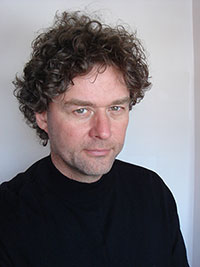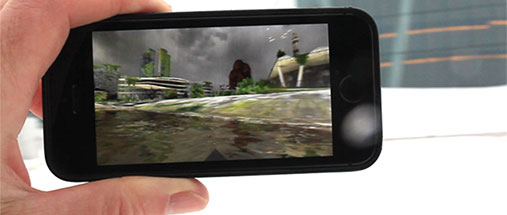Imagine standing on your veranda, holding your smartphone up in the air. Then you choose a year in the future, and on the screen you can see what the view from your veranda will look like one hundred years from now – or two hundred, or three hundred. The app that can make this possible might soon become a reality, if Gunnar Liestøl, professor of media studies, gets his way.
‘The technology is there. In theory, this is both achievable and affordable,’ says Liestøl, professor at the Department of Media and Communication (IMK).
Recently, he launched two prototypes. They show the Opera House in Bjørvika in Oslo and a hillside on the Hardangerfjord, where climate change has really started to bite.
May visualize climate change
Liestøl has developed the technology Situated Simulations, which functions as a time machine on your mobile. You can download an app that will show your surroundings in another era, past or future.
There are apps that provide views of the ancient Forum Romanum in Rome (iTunes, GooglePlay), the port city of Ancient Phalasarna in Crete (iTunes), the Viking Age in Borre Park near Horten (iTunes) and the new National Museum at Oslo’s former western railway station iTunes, GooglePlay).
Liestøl started his efforts to show the possible consequences of climate change a few years ago. His goal is to develop an app that covers all of Norway.
‘Communicating the climate problem represents a major challenge, partly because we cannot visualize what may happen,’ Liestøl says.
‘We hope to obtain funding to complete the project, because we believe that it may have a significant educational potential. If students across the country can simulate a possible future in their home communities, they might perceive climate change something of more immediate concern to them.’
Visualizing a two-metre rise in sea levels

One of the prototypes shows the Opera House in Oslo in 2222. It is based on a worst-case climate scenario that involves a two-metre rise in sea levels.
On the screen we can see that the lower part of the opera building is immersed in water. Above the waterline moss and green plants grow on the white marble. A sign reading ‘Danger: Abandoned structure’ lights up, and a deer leaps by, looking back at us uneasily. The other high-rises in the Bjørvika district are also covered in moss and abandoned.
‘The sea level is unlikely to rise by two metres by 2222, but we chose to use a dramatic scenario because we wanted to test the technology’s educational potential. A scenario that was more similar to the current situation would not speak as directly to the students’ imagination,’ Liestøl explains.
Testing the app on ninth-graders
In collaboration with Ola Erstad and Ole Smørdal at the Department of Education at UiO, he let a group of ninth-graders in Oslo use the app as the basis for a project on climate change. The students were provided with iPhones and iPads that they brought with them to the Opera House.
In the simulation, the researchers had also added questions for the students to discuss in groups back in the classroom. The students were presented with the questions in the form of clickable signposts on the screen.
‘The questions asked the students to enter explanations of what might have happened in Oslo from 2014 to 2222. It revealed itself to be a success. The students succeeded in linking their observations of the physical environment with the things they could see on the screen. They had some very good reflections on what might have caused these changes,’ says Liestøl, who describes the experience from the project in two research articles that have already been published, with one more forthcoming.
The technology behind it
The Sitsim platform has been developed at IMK in collaboration with the software developers CodeGrind AB and Tag of Joy. The technology takes the user into a so-called ‘augmented reality’.
The basic computer program uses four sensors inside the smartphone or tablet computer to calculate where they are and how they are moving: GPS coordinates show your location, the electronic compass gives the direction, the accelerometer registers how the mobile moves with gravity and the gyro records swings and rotations.
If the climate prototype is developed into an app that simulates climate change all over Norway, it will retrieve cartographic data from the Norwegian Mapping Authority and data sets for vegetation and growing conditions from the Norwegian Forest and Landscape Institute. The data are available, but the researchers will need support to establish a server that can make this information readable and usable.
Contact
Studies
View simulations:
- Forum Romanum in Rome (iTunes, GooglePlay)
- Ancient Phalasarna at Crete (iTunes),
- Viking Age at Borreparken in Horten (iTunes)
- The new Nasjonal Museum in Oslo (iTunes, GooglePlay).

Climate as topic in other research in the humanities
Today, sustainability is a fundamental principle of design in education, research and dissemination. This project describes the history of the ‘green revolution’ in the field of design, focusing on the period from the late 1960s until today. Where did eco-thinking originate? What strategies have been tested to ensure sustainability in design? The researchers take a broad view of design; their concept includes not only fashion, but our entire material world. Professor Kjetil Fallan at the Department of Philosophy, Classics, History of Art and Ideas is the project director.
The Airborne project studies the human dimensions of air pollution in China. In what ways are the visions of the Chinese regarding sustainability and emissions reduction affected by their personal experience of air pollution? The researchers are looking both backwards and forwards in time to understand how people’s experiences, along with scientific knowledge on the environment and climate change, help determine future environmental policy and ways of living in China. The project is headed by Mette Halskov Hansen, professor at the Department of Culture Studies and Oriental Languages.
Other individual researchers
- Mark Luccarelli is a cultural historian and associate professor at the Department of Literature, Area Studies and European Languages and concerned with why so many people in the West have stopped worrying about environmental issues. Why has the environment become largely a question of technology and not a question of people? In 2007, Luccarelli founded the Nordic Network for Interdisciplinary Environmental Studies in collaboration with colleagues from Denmark and Sweden. The network has arranged a series of conferences. Luccarelli is also editor of the book series ‘Studies in the Environmental Humanities’ published by Brill.
- Peder D. Anker is professor at New York University and professor II at the Department of Archaeology, Conservation and History. His field is climate and environmental history, and he heads the Norwegian research group ‘Histories of Climate Adaptation’. He has also written a number of books on eco-design and environmental history. He is currently working on a book on how certain Norwegian researchers and environmental activists influenced the debate on environmental issues both in Norway and abroad from the 1960s and beyond 2000.
- Øyvind Ihlen is professor at the Department of Media and Communication and has studied communication by petroleum companies, especially their use of the term ‘sustainability’. Going forward, he hopes to work on the use of the terms ‘green transition’ and ‘de-carbonization’ by industry. For example, he wants to study the kinds of definitions that are used, how these concepts are debated in the media and the characteristics of enterprises that set ambitious goals for themselves in this area.
- Brynjar Lia is professor at the Department of Culture Studies and Oriental Languages. His interests include the development of renewable energy in the Middle East and the social and political consequences of a transition to green energy in this region. He has recently applied to the Research Council of Norway for funding of a three-year project entitled: ‘Climate Change and Energy Transition in the Middle East and North Africa: Discourse, practice, and state-society relations (GreenMENA)’.
